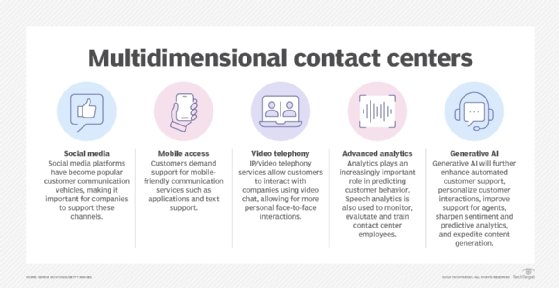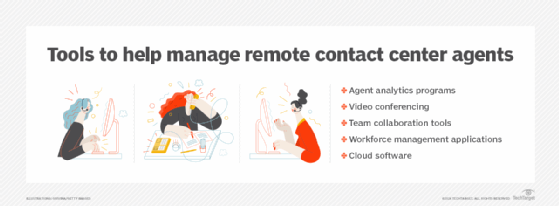How to manage today's remote contact center agents
Technologies like agent analytics, video conferencing, collaboration tools, workforce management applications and cloud software can help manage remote contact centers.
A few key technology implementations can make all the difference between successful and unsuccessful remote contact center agent management.
As work-from-home has become widely accepted in contact centers, a solid technology strategy is crucial to easing the burden on contact center supervisors. In particular, AI capabilities embedded in workforce engagement management suites, along with integrated communication platforms, should be on any company's must-have list when operating a remote contact center.
How has contact center management changed?
Contact centers have permitted select agents to work from home for many years -- driven by shortages in workers in specific regions, the desire to keep agents who had to move away from the contact center or to support growth when they outgrew their physical center.
Starting in 2020, as the global pandemic intensified, contact center supervisors and agents swiftly moved to home offices. And because technology was able to support it, CX leaders found value in continuing with the practice.
However, that permanent shift created angst among contact center supervisors accustomed to walking the aisles and managing their teams face-to-face. Management now uses different technologies and techniques, including the following:
- Video conferencing and screen sharing to effectively manage staff.
- AI-powered, virtual coaching to give agents real-time advice in short sprints throughout the day; 43.7% of companies use AI this way, according to Metrigy's "AI for Business Success 2024-25" global study of 697 companies.
- Supervisor-led coaching using AI-powered summary reports that evaluate every agent call to improve quality assurance vs. supervisors sporadically listening to calls.
- Real-time customer sentiment for each member of a supervisor's team so they're alerted when they need to help an agent -- a practice cited by 57% of companies using agent assist, according to the same study.
- Integration between internal unified communications platforms and contact center platforms to create collaboration spaces and bring in experts to assist with customer inquiries.
- AI-based capacity planning and scheduling capabilities that save supervisors 119 minutes per week, according to the Metrigy study.

What are the benefits of remote contact centers?
Thanks to the aforementioned technology innovations, remote contact centers aren't the management headache they once were. In fact, CX leaders view them as a must-have to attract the best people and reduce agent attrition -- which now hovers around 31%, according to Metrigy research.
Remote contact center benefits include the following:
- Agents have more flexibility to work split shifts, eliminate commute time and expenses and improve their work/life balance.
- Virtual contact centers help businesses reduce real estate costs; attract the best people, regardless of their physical location; decrease costs to recruit, hire and train new employees because turnover rates drop when agents can work from home; and make it easier to call in agents during unexpected busy times.
Challenges in managing remote agents
The shift from a traditional office environment to a work-from-home strategy clearly has created obstacles for contact center supervisors, such as the following:
- Evaluation. In-person evaluations might not happen as frequently or not at all, depending on the distance between the agent and supervisor.
- Problem resolution. Supervisors have lost the ability to provide face-to-face guidance.
- Collaboration. Supervisors and agents could be more challenged to perform collaborative tasks that were simple to do in person, such as track communications, add other team members into their discussions, jointly view documents or track associated documents.
- Scheduling. Organizations that once posted schedules on office whiteboards or paper now have to implement remote-friendly scheduling platforms.
Tools to help manage remote contact center agents
Contact center managers can overcome remote work challenges with the following tools:
- Agent analytics programs. Analytics programs, particularly those that use AI, offer more agent performance data than human observation, along with data to enhance coaching sessions.
- Video conferencing. One-on-one video calls between supervisors and agents are more engaging than standard voice calls, as they capture facial expressions and body language in addition to speech. Also, video conferencing enhances team meetings and agent training programs.
- Team collaboration tools. Team workspaces let contact center supervisors and agents participate in chats, segment topics of interest or concern, and interact with people outside the contact center. For example, product managers might want to include key agents in discussions about new upgrades based on input from customer discussions.
- Workforce management applications. WFM software helps remote supervisors create schedules based on demand and lets remote agents view their schedules and trade shifts from home. It also automates capacity planning, resulting in faster and more accurate schedule creation.
- Cloud software. Cloud-based applications equip remote contact center agents with tools to do their jobs from home. Cloud systems can also simplify growth and change based on customer demands. Large, customized and complex contact centers with on-premises platforms can also benefit from cloud apps.
Remote work strategies offer increased flexibility for workers and reduced real estate costs for organizations. While the remote work model challenges contact center management, digital tools such as agent analytics, video conferencing, collaboration tools, WFM applications and cloud software provide a viable strategy.

6 tips to get the most out of remote contact center agents
Remote contact centers are here to stay, and they deliver benefits to those that use the following strategies to keep agents engaged and motivated:
- Invest in collaborative technologies that help agents feel connected even though they work remotely.
- Build a solid onboarding and training program. More than 42% of companies use AI-powered training to onboard agents faster and deliver repetitive training reminders several times a day during their first few months, according to the Metrigy study.
- Schedule and adhere to regular video calls to provide and gather feedback from remote contact center agents.
- Implement scheduling flexibility to develop schedules that allow for split shifts, part-time hours or longer but fewer days of work.
- Prioritize employee recognition with technologies such as gamification. Leader boards can be just as effective when virtual, and rewards can be noted there.
- Track metrics. Determine what makes a superior remote contact center agent and supervisor, implement the analytics tools to track those metrics and report on them regularly. Then act to make sure agents are always improving.
Editor's note: This article was updated in August 2024 to reflect changing contact center technology, provide updated research information and improve the reader experience.
Robin Gareiss is CEO and principal analyst at Metrigy, which conducts research and advises enterprises and technology providers.







